
Frank Steunenberg was the fourth governor of the State of Idaho, serving from 1897 until 1901. He was assassinated in 1905 by one-time union member Harry Orchard, who was also a paid informant for the Cripple Creek Mine Owners' Association. Orchard attempted to implicate leaders of the radical Western Federation of Miners in the assassination. The labor leaders were found not guilty in two trials, but Orchard spent the rest of his life in prison.

The Copper River and Northwestern Railway (CR&NW) consisted of two rail lines, the Copper River line and the Northwestern line. Michael James Heney had secured the right-of-way up the Copper River in 1904. He started building the railway from Cordova, Alaska in 1906. The town of Cordova, Alaska, was actually named by Heney on March 13, 1906, based on the original name given by Salvador Fidalgo. Both these railroads were abandoned and little remains of them. A 0-4-0 locomotive, "Ole", located near Goose City on a siding of the Alaska Anthracite Railroad Company is the only equipment left. Many of the holdings of the CR&NW railroad including Ole were acquired for this railroad by Mr. Clark Davis and his partners in 1908 after a major storm destroyed the Katalla area facilities in 1907. The town of Cordova would like to move Ole to a memorial site in Cordova to celebrate its role in these railroads. Ole was declared eligible for the National Register of Historic Places in 1988.

Albert Edward Horsley, best known by the pseudonym Harry Orchard, was a miner convicted of the 1905 political assassination of former Idaho Governor Frank Steunenberg. The case was one of the most sensational and widely reported of the first decade of the 20th century, involving three prominent leaders of the radical Western Federation of Miners as co-defendants in an alleged conspiracy to commit murder.

Frank Robert Gooding was a Republican United States Senator and the seventh governor of Idaho. The city of Gooding and Gooding County, both in southern Idaho, are named for him.

The Idaho Press of Nampa, Idaho is the second-oldest active newspaper in Idaho, first printed in December 1883. In its early years, the newspaper was often an instrument of political influence. One of the first owners and editors was Frank Steunenberg.

The Corbin Building is a historic office building at the northeast corner of John Street and Broadway in the Financial District of Manhattan in New York City. It was built in 1888–1889 as a speculative development and was designed by Francis H. Kimball in the Romanesque Revival style with French Gothic detailing. The building was named for Austin Corbin, a president of the Long Island Rail Road who also founded several banks.

John Everett Tourtellotte was a prominent western American architect, best known for his projects in Idaho. His work in Boise included the Idaho State Capitol, the Boise City National Bank, the Carnegie Library, and numerous other buildings for schools, universities, churches, and government institutions. From 1922 to 1930, he worked in Portland, Oregon.

The A.W. Patterson House is a historic house in Muskogee, Oklahoma. Located at the intersection of 14th Street and West Okmulgee, it is situated at the crest of a hill near the western edge of the downtown Muskogee neighborhood. It was built in 1906, before Oklahoma achieved statehood in 1907. It was listed on the National Register of Historic Places in 1984.

Wayland & Fennell was an architectural firm in Idaho. Many of their works are listed on the U.S. National Register of Historic Places.

The John Haines House is a 2+1⁄2-story Queen Anne style house in the Fort Street Historic District of Boise, Idaho. Designed by Tourtellotte & Co. and constructed in 1904, the house features a veneer of rectangular cut stone applied to the first story and shingled, flared walls at the second story. Turrets accent the front two corners of the house, and a classical porch with doric columns and a flattened pediment separates the offset main entrance from the street. It was included as a contributing property in the Fort Street Historic District on November 12, 1982. The house was individually listed on the National Register of Historic Places on November 17, 1982.
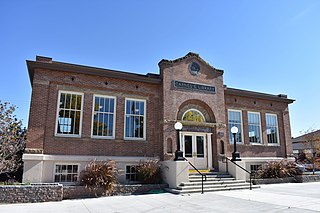
The Caldwell Carnegie Library in Caldwell, Idaho, also known as the Caldwell Veterans Memorial Hall, was constructed from a grant by the Carnegie library foundation. The building opened in 1914 and was added to the National Register of Historic Places June 18, 1979. Its modest, 1-story Renaissance design is credited to Charles Carroll Soule and features reading rooms on either side of the main entrance. The building also includes a full basement with lecture hall.

The Caldwell Historic District in Caldwell, Idaho, is an area of approximately four acres in downtown Caldwell along Main Street, South 7th Avenue, South Kimball Avenue, and Arthur Street.
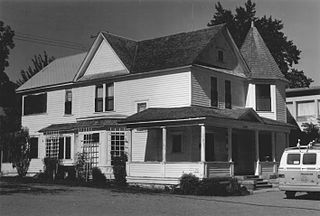
The John C. Rice House is a 2-story, Queen Anne style house constructed in 1896 in the Washington Heights neighborhood, afterwards relocated to 2121 College Ave> of Caldwell, Idaho. The house features an octagonal turret at the south end of a wraparound porch, a gable roof, and (originally) a lava rock foundation. In 1904 a cement sidewalk was constructed from the Rice House to downtown Caldwell, a distance of approximately 16 blocks.

The Boise City National Bank building in Boise, Idaho, was designed by architect James King as a 3-story, Richardsonian Romanesque commercial structure, inspired by the Marshall Field's Wholesale Store in Chicago. Construction began in April, 1891, and the building was completed in 1892.

Walter E. Pierce was a prominent real estate speculator in Boise City, Idaho, USA, in the late 19th century and in the first half of the 20th century. Pierce served as mayor of Boise City 1895-97 as it evolved from being a frontier community to being a modern town.

The West Warm Springs Historic District in Boise, Idaho, is a neighborhood of homes of some of Boise's prominent citizens of the late 19th and early 20th centuries. Roughly bounded by W Main St, W Idaho St, N 1st St, and N 2nd St, the district was added to the National Register of Historic Places in 1977 and included 14 properties. Of these original resources, 11 remain in the district.
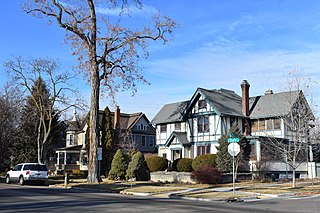
The State Street Historic District in Boise, Idaho, is a group of houses constructed between 1886 and 1940 along West Jefferson and State Streets, bounded by North 2nd and 3rd Streets. The houses represent a variety of architectural styles, and some were occupied by politicians and judges during the early 20th century. The historic district was added to the National Register of Historic Places in 1978.
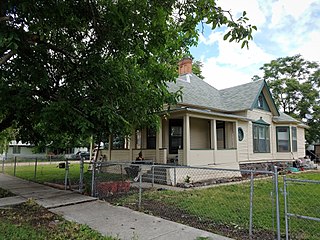
The Thomas K. Little House is a 1+1⁄2-story Queen Anne style house built for the Littles by Robert E. Miller in 1896 in Caldwell, Idaho. Added to the National Register of Historic Places in 1980, the house features an irregular pattern with small rooms constructed around two parlors, and it sits on a lava rock foundation.
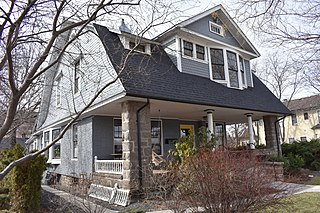
The Dr. James Davies House in Boise, Idaho, is a 2-story, shingled Colonial Revival house designed by Tourtellotte & Co. and constructed in 1904. The first floor is veneered in composite brick which may not be original to the house. The shingled upper story has flared walls at its base and small shed roof decorations above side windows. Other prominent features include a gambrel roof that extends over a cross facade porch with stone pillars at its front corners. The right front portion of the roof at its curb is cut inward of the lateral ridgebeam to expose a small, second-floor balcony above a beveled side bay. A large, pedimented front gable includes an off center, mullioned spider web window.

The Albert Beck House in Boise, Idaho, is a 1+1⁄2-story Queen Anne house designed by Tourtellotte & Co. and constructed in 1904. The house features sandstone veneer on its first floor walls and on a wrap around porch. Overhanging gables with dimpled dormer vents were prominent at the Fort Street and 11th Street exposures. The house was added to the National Register of Historic Places in 1982.






















